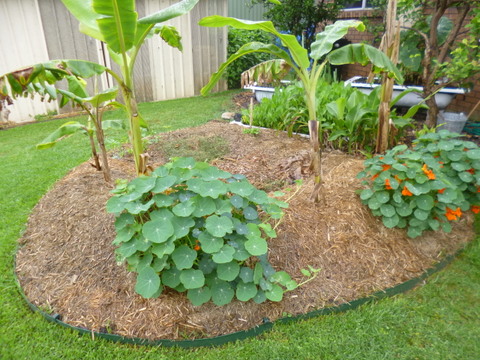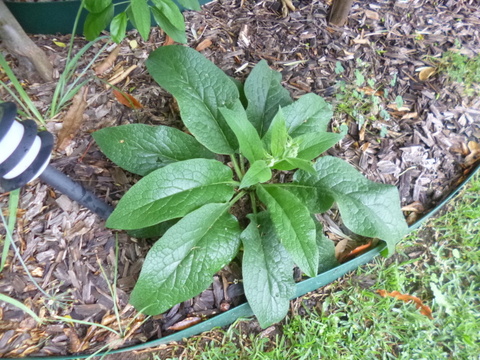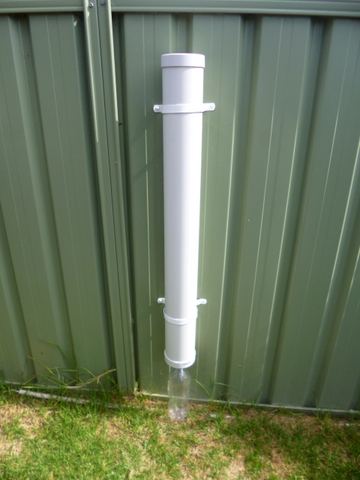One of the differences between a permaculture approach to growing food and other “organic” growing regimes is the practice of growing productive plants together in a mutually beneficial arrangement called a guild. This is how the term “guild” is defined by Bill Mollison Co-developer of the permaculture system -
A Guild is a harmonious assembly of species clustered around a central element (plant or animal) that acts in relation to this element to assist its health, aid our work in management, or buffer adverse environmental effects (Mollison).
Other people also have written about guilds over the years, in her book “The Wilderness Garden” Jackie French also refers to guilds but calls them “groves” instead.
Why Grow Using Guilds
There are a number of reasons why it is a good idea to grow using guilds, these include -
Nature does some of the work – in a correctly designed guild, plants work together to improve the health and productivity of the entire guild, this means work which would normally have to be done by a gardener or farmer is done or encourage by the plants themselves.
Improved pollination – Rather than leaving pollination to chance, a guild is designed to be insect and/or bird pollinator friendly by providing food and a suitable habitat. This means they are attracted into the guild and then hang around, improving the pollination rates and hence productivity of your fruiting species.
Greater productivity – Due to the mutual reinforcement or synergy of plants within the guild, the productivity of the space is increased. This is not only due to the presence of pollinators but also the presence of plant pest predators and plants which provide mulch and improve soil fertility.
Greater variety of food from a given space – The common wisdom says don’t grow anything (especially grass!) under fruit trees, but in reality if you plant other beneficial species it will not only be better for the tree, but it will make the whole area more productive as well.
Reduced chemical usage – If you are working with nature there is no need for chemical fertilisers, which can pollute groundwater or pesticides which kill bees and other beneficial organisms as well as the target bugs. Let’s face it, if you want to eat fruit and veg contaminated with pesticides, you may as well buy the commercially produced stuff!
Improved biodiversity – rather than just lawn and a fruit tree, you get a variety of plants and in turn a variety of insects, birds, lizards, spiders etc. All of a sudden you are developing a whole ecosystem where one did not exist before and you will have lots of interesting things happening in your garden.
More resilient way to grow – If you grow one crop (fruit) and you get a failure, say due to lack of pollinators resulting in no fruit, you have to wait until the same time next year to get a harvest (assuming you’ve fixed the problem). With a variety of plants you are almost guaranteed to get a yield of some description regardless of growing conditions.
Types of Guild
There are three types of guilds which you can design -
- Community function guild – In this type of guild there is a grouping of species which do a specific job or fill a specific niche and are grown together for example insectary plants, nitrogen fixers or medicinal or culinary herbs.
- Resource partitioning guild – where several species share resources through niche differentiation eg taproots with shallow rooted species or species which produce early in the season then die back to allow later varieties/types to produce without competition.
- Mutual support guild – This is the classic guild where complementary species are planted together and support each other. It is this type of guild which is the focus of this article.
Plant Jobs/functions Within a Guild
The plants which we design into our guilds perform a number of functions or “jobs” within the guild. There are 8 types of jobs and while some plants may only perform one job, many will perform multiple jobs and some, like comfrey, may perform up to six different roles at once.
1. Feeders
These are plants which feed us and/or our animals, they may be the central element of the guild in the form of a full sized fruit or nut tree or they may be a smaller fruiting species out from the central element. This group is also comprised of perennial and annual vegetables, herbs and edible flowers.
Examples of plants which could be used as the central element include citrus, pome, stone or tropical fruit trees but may just as easily be a nut tree such as macadamia, walnut, almond, hazelnut or pecan. Other trees which might find use for the central element include trees with edible leaves such as the curry leaf tree, kaffir lime tree or the bay leaf tree.
Other edible trees or bushes outside the central element include dwarf versions of above fruit or nut trees, berry bushes/canes such as blueberry, blackberry, youngberry or gooseberry. This list of annual vegetables is long and most will find a place in a guild, just bear in mind that the more effort required to get an annual vegetable to grow and yield, the easier it needs to be for you to be able to get at it so locate it near the edge of the guild.
Don’t forget perennial vegetables such as the choko, globe artichoke, Jerusalem artichoke, perennial spinach, dandelion and chicory. In particular, leaf crops can do very well in the more shady parts of the guild. Culinary and medicinal herbs such as lemongrass, rosemary, sage, dill, thyme, and oregano also fit into this group.
Last but not least there are a host of edible flowers including Nasturtiums, marigold, lavender, English daisy, tuberous begonias, daylily, pinks (dianthus) and violas. These can be integrated into your guild to provide food, colour and attract beneficial insects.
2. Fertilisers
There are two types of plants which can improve the fertility of the soil – nitrogen fixers (legumes) which support nitrogen fixing bacteria in nodules in their roots. Such plants include dwarf and climbing Peas, dwarf and climbing beans, broad beans, clover (red, white, subterranean), lucerne, medic, lupins, fenugreek, mung bean, cow pea, peanut, vetch, wattles, Australian indigo, chick pea and lab lab bean. When the plant dies the nitrogen accumulated during the life of the plant becomes available for the use of other plants.
The second type of fertilising plants are dynamic accumulators, which use long taproots to access nutrients which are out of reach of more shallow rooted species. They accumulate these nutrients in their leaves which can be cut as mulch or the plant left to complete its life cycle and release the nutrients when it dies. Nutrients can also be extracted from the leaves using a tube and weight, then applied to other plants as a diluted nutrient “tea”.
Dynamic accumulators include borage, stinging nettle, comfrey, broad-leafed dock, horsetail, fat hen, parsley, plantains, yarrow and salad burnet.
3. Diggers
(or as an ex-army friend of mine would rather have them – Miners) - These plants help to break up the soil and make it more friable, improving water penetration, soil aeration and drainage. Generally they are root crops and plants with deep root systems, examples include Potatoes, daikon radish, sweet potatoes, cassava, yams, arrowroot, beets, turnips, trees & bushes and dynamic accumulators such as dandelion, comfrey and chicory.
4. Mulchers
There are really three classes of plants which fit into this category: mulchers pure and simple, groundcovers and green manures. Mulchers produce large amounts of soft leaves which can be cut and left on the soil (chop and drop) to break down forming a mulch and releasing nutrients. Groundcovers, form a living mulch which protects the soil by growing a barrier of plant material between the soil and the sun, wind and rain. Green manures are allowed to grow until before the point of flowering then slashed to provide plant material which can be used as mulch or dug in to break down and provide increased fertility that way.
Examples of mulchers include comfrey, artichokes, rhubarb, nasturtiums, plantain (major), dock, deciduous fruit trees, beans, burdock, mallow, tagasaste, and warrigal greens. Examples of green manure crops – clovers, barley, beets, buckwheat, mustard, rocket, millet, purslane, turnip, wheat, basil and dill. Examples of ground cover plants include pumpkin, squash, strawberries, clover, sweet potato, creeping thyme, mint, creeping rosemary.
5. Climbers
Climbers increase productivity by using vertical space to produce food and other products while maximizing horizontal space. They can be grown up structures like sheds, houses or pergolas or they can be grown up mature trees or other plants with the job of supporter. They also can provide shade for shade loving species and to reduce the effect of the hot summer sun. Vigorous climbers can be trimmed back to provide organic material for mulch. Examples of productive climbers include (Perennial species) choko, passionfruit, kiwifruit, hops, sweet potato, scarlet runner beans and jasmine, (Annual species) cucumber, climbing beans and climbing peas.
6. Supporters
The plants provide a framework which allows climbers to make use of their vertical space while being productive in themselves. They can also be used to shade spaces within the guild. Examples of plants which act as supporters include Sunflower, Jerusalem artichoke, sweet corn, dent corn, fruit and nut trees, shrubs and bushes.
7. Protectors
Plants may protect each other from pest attack, disease or competition by a variety of strategies. One strategy is used by pest confusers these plants are highly aromatic and confuse a pest’s sense of smell, making it more difficult to identify target plants. Examples of pest confusers include basil, chamomile, coriander, dill, fennel, garlic, horehound, lavender, marigolds, mustard, nasturtiums, onions, pennyroyal, rue, tansy, wormwood and yarrow. Others are called competition barriers and these plants can be planted around beneficial species to prevent competition from grass, weeds or other invasive plants. Examples of competition barriers include daffodils, comfrey and perennial alliums (garlic chives, wild leek or Egyptian onions) which are planted in a circle around the central element to prevent competition from grasses.
8. Attractors
These plants are used for their ability to attract beneficial species into the guild. They may be predator attractors which attract beneficial insects or birds which will predate the pest insect species that cause damage to plants within the guild. They may attract pollinators (insects, birds, microbats etc.) which will provide pollination services to the plants within the guild, ensuring a good yield. Plants which attract pollinating and/or predatory insects include alyssum, bergamot, calendula, chicory, cosmos, gypsophila, heartsease, lavender, lupins, marguerite daisy, nasturtium, Queen Anne's lace, yarrow, zinnia. Grevilleas, banksias and melaleucas and the above mentioned insect attracting flowers will also attract insect eating and pollinating birds if they are in your area.
Part 2 – Hints and tips for assessing your site then choosing and positioning your plants






